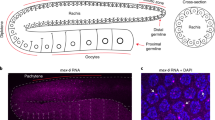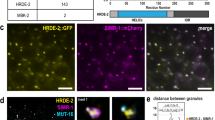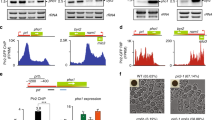Abstract
Argonaute proteins and their small RNA cofactors short interfering RNAs are known to inhibit gene expression at the transcriptional and post-transcriptional levels. In Caenorhabditis elegans, the Argonaute CSR-1 binds thousands of endogenous siRNAs (endo-siRNAs) that are antisense to germline transcripts. However, its role in gene expression regulation remains controversial. Here we used genome-wide profiling of nascent RNA transcripts and found that the CSR-1 RNA interference pathway promoted sense-oriented RNA polymerase II transcription. Moreover, a loss of CSR-1 function resulted in global increase in antisense transcription and ectopic transcription of silent chromatin domains, which led to reduced chromatin incorporation of centromere-specific histone H3. On the basis of these findings, we propose that the CSR-1 pathway helps maintain the directionality of active transcription, thereby propagating the distinction between transcriptionally active and silent genomic regions.
This is a preview of subscription content, access via your institution
Access options
Subscribe to this journal
Receive 12 print issues and online access
$189.00 per year
only $15.75 per issue
Buy this article
- Purchase on Springer Link
- Instant access to full article PDF
Prices may be subject to local taxes which are calculated during checkout







Similar content being viewed by others
Accession codes
References
Grewal, S.I. RNAi-dependent formation of heterochromatin and its diverse functions. Curr. Opin. Genet. Dev. 20, 134–141 (2010).
Kim, V.N., Han, J. & Siomi, M.C. Biogenesis of small RNAs in animals. Nat. Rev. Mol. Cell Biol. 10, 126–139 (2009).
Hammond, S.M. Dicing and slicing: the core machinery of the RNA interference pathway. FEBS Lett. 579, 5822–5829 (2005).
Ambros, V., Lee, R.C., Lavanway, A., Williams, P.T. & Jewell, D. MicroRNAs and other tiny endogenous RNAs in C. elegans. Curr. Biol. 13, 807–818 (2003).
Okamura, K. & Lai, E.C. Endogenous small interfering RNAs in animals. Nat. Rev. Mol. Cell Biol. 9, 673–678 (2008).
Lau, N.C. Small RNAs in the animal gonad: guarding genomes and guiding development. Int. J. Biochem. Cell Biol. 42, 1334–1347 (2010).
Grishok, A. Biology and mechanisms of short RNAs in Caenorhabditis elegans. Adv. Genet. 83, 1–69 (2013).
Moshkovich, N. et al. RNAi-independent role for Argonaute2 in CTCF/CP190 chromatin insulator function. Genes Dev. 25, 1686–1701 (2011).
Cernilogar, F.M. et al. Chromatin-associated RNA interference components contribute to transcriptional regulation in Drosophila. Nature 480, 391–395 (2011).
Taliaferro, J.M. et al. Two new and distinct roles for Drosophila Argonaute-2 in the nucleus: alternative pre-mRNA splicing and transcriptional repression. Genes Dev. 27, 378–389 (2013).
Huang, V. et al. Ago1 interacts with RNA polymerase II and binds to the promoters of actively transcribed genes in human cancer cells. PLoS Genet. 9, e1003821 (2013).
Ameyar-Zazoua, M. et al. Argonaute proteins couple chromatin silencing to alternative splicing. Nat. Struct. Mol. Biol. 19, 998–1004 (2012).
Cecere, G. & Grishok, A. A nuclear perspective on RNAi pathways in metazoans. Biochim. Biophys. Acta 1839, 223–233 (2014).
Gu, W. et al. Distinct argonaute-mediated 22G-RNA pathways direct genome surveillance in the C. elegans germline. Mol. Cell 36, 231–244 (2009).
Claycomb, J.M. et al. The Argonaute CSR-1 and its 22G-RNA cofactors are required for holocentric chromosome segregation. Cell 139, 123–134 (2009).
van Wolfswinkel, J.C. et al. CDE-1 affects chromosome segregation through uridylation of CSR-1-bound siRNAs. Cell 139, 135–148 (2009).
Yigit, E. et al. Analysis of the C. elegans Argonaute family reveals that distinct Argonautes act sequentially during RNAi. Cell 127, 747–757 (2006).
She, X., Xu, X., Fedotov, A., Kelly, W.G. & Maine, E.M. Regulation of heterochromatin assembly on unpaired chromosomes during Caenorhabditis elegans meiosis by components of a small RNA-mediated pathway. PLoS Genet. 5, e1000624 (2009).
Duchaine, T.F. et al. Functional proteomics reveals the biochemical niche of C. elegans DCR-1 in multiple small-RNA-mediated pathways. Cell 124, 343–354 (2006).
Maine, E.M. et al. EGO-1, a putative RNA-dependent RNA polymerase, is required for heterochromatin assembly on unpaired DNA during C. elegans meiosis. Curr. Biol. 15, 1972–1978 (2005).
Vought, V.E., Ohmachi, M., Lee, M.H. & Maine, E.M. EGO-1, a putative RNA-directed RNA polymerase, promotes germline proliferation in parallel with GLP-1/notch signaling and regulates the spatial organization of nuclear pore complexes and germline P granules in Caenorhabditis elegans. Genetics 170, 1121–1132 (2005).
Updike, D.L. & Strome, S. A genomewide RNAi screen for genes that affect the stability, distribution and function of P granules in Caenorhabditis elegans. Genetics 183, 1397–1419 (2009).
Nakamura, M. et al. Dicer-related drh-3 gene functions in germ-line development by maintenance of chromosomal integrity in Caenorhabditis elegans. Genes Cells 12, 997–1010 (2007).
Avgousti, D.C., Palani, S., Sherman, Y. & Grishok, A. CSR-1 RNAi pathway positively regulates histone expression in C. elegans. EMBO J. 31, 3821–3832 (2012).
Conine, C.C. et al. Argonautes promote male fertility and provide a paternal memory of germline gene expression in C. elegans. Cell 155, 1532–1544 (2013).
Core, L.J., Waterfall, J.J. & Lis, J.T. Nascent RNA sequencing reveals widespread pausing and divergent initiation at human promoters. Science 322, 1845–1848 (2008).
Cecere, G., Hoersch, S., Jensen, M.B., Dixit, S. & Grishok, A. The ZFP-1(AF10)/DOT-1 complex opposes H2B ubiquitination to reduce Pol II transcription. Mol. Cell 50, 894–907 (2013).
Anders, S. & Huber, W. Differential expression analysis for sequence count data. Genome Biol. 11, R106 (2010).
Reinke, V. et al. A global profile of germline gene expression in C. elegans. Mol. Cell 6, 605–616 (2000).
Wang, X. et al. Identification of genes expressed in the hermaphrodite germ line of C. elegans using SAGE. BMC Genomics 10, 213 (2009).
Rechtsteiner, A. et al. The histone H3K36 methyltransferase MES-4 acts epigenetically to transmit the memory of germline gene expression to progeny. PLoS Genet. 6, e1001091 (2010).
Kolasinska-Zwierz, P. et al. Differential chromatin marking of introns and expressed exons by H3K36me3. Nat. Genet. 41, 376–381 (2009).
Furuhashi, H. et al. Trans-generational epigenetic regulation of C. elegans primordial germ cells. Epigenetics Chromatin 3, 15 (2010).
Gaydos, L.J., Rechtsteiner, A., Egelhofer, T.A., Carroll, C.R. & Strome, S. Antagonism between MES-4 and Polycomb repressive complex 2 promotes appropriate gene expression in C. elegans germ cells. Cell Reports 2, 1169–1177 (2012).
Gassmann, R. et al. An inverse relationship to germline transcription defines centromeric chromatin in C. elegans. Nature 484, 534–537 (2012).
Lee, H.C. et al. C. elegans piRNAs mediate the genome-wide surveillance of germline transcripts. Cell 150, 78–87 (2012).
Bagijn, M.P. et al. Function, targets, and evolution of Caenorhabditis elegans piRNAs. Science 337, 574–578 (2012).
Shirayama, M. et al. piRNAs initiate an epigenetic memory of nonself RNA in the C. elegans germline. Cell 150, 65–77 (2012).
Ashe, A. et al. piRNAs can trigger a multigenerational epigenetic memory in the germline of C. elegans. Cell 150, 88–99 (2012).
Luteijn, M.J. et al. Extremely stable Piwi-induced gene silencing in Caenorhabditis elegans. EMBO J. 31, 3422–3430 (2012).
Lei, E.P. & Corces, V.G. RNA interference machinery influences the nuclear organization of a chromatin insulator. Nat. Genet. 38, 936–941 (2006).
Perkins, K.J., Lusic, M., Mitar, I., Giacca, M. & Proudfoot, N.J. Transcription-dependent gene looping of the HIV-1 provirus is dictated by recognition of pre-mRNA processing signals. Mol. Cell 29, 56–68 (2008).
Mapendano, C.K., Lykke-Andersen, S., Kjems, J., Bertrand, E. & Jensen, T.H. Crosstalk between mRNA 3′ end processing and transcription initiation. Mol. Cell 40, 410–422 (2010).
Tan-Wong, S.M. et al. Gene loops enhance transcriptional directionality. Science 338, 671–675 (2012).
Friend, K. et al. A conserved PUF-Ago-eEF1A complex attenuates translation elongation. Nat. Struct. Mol. Biol. 19, 176–183 (2012).
Maniar, J.M. & Fire, A.Z. EGO-1, a C. elegans RdRP, modulates gene expression via production of mRNA-templated short antisense RNAs. Curr. Biol. 21, 449–459 (2011).
Liu, T. et al. Broad chromosomal domains of histone modification patterns in C. elegans. Genome Res. 21, 227–236 (2011).
Wedeles, C.J., Wu, M.Z. & Claycomb, J.M. Protection of germline gene expression by the C. elegans Argonaute CSR-1. Dev. Cell 27, 664–671 (2013).
Seth, M. et al. The C. elegans CSR-1 Argonaute pathway counteracts epigenetic silencing to promote germline gene expression. Dev. Cell 27, 656–663 (2013).
Li, L.C. et al. Small dsRNAs induce transcriptional activation in human cells. Proc. Natl. Acad. Sci. USA 103, 17337–17342 (2006).
Schwartz, J.C. et al. Antisense transcripts are targets for activating small RNAs. Nat. Struct. Mol. Biol. 15, 842–848 (2008).
Chu, Y., Yue, X., Younger, S.T., Janowski, B.A. & Corey, D.R. Involvement of argonaute proteins in gene silencing and activation by RNAs complementary to a non-coding transcript at the progesterone receptor promoter. Nucleic Acids Res. 38, 7736–7748 (2010).
Hu, J. et al. Promoter-associated small double-stranded RNA interacts with heterogeneous nuclear ribonucleoprotein A2/B1 to induce transcriptional activation. Biochem. J. 447, 407–416 (2012).
Brenner, S. The genetics of Caenorhabditis elegans. Genetics 77, 71–94 (1974).
Liu, T. et al. Cistrome: an integrative platform for transcriptional regulation studies. Genome Biol. 12, R83 (2011).
Acknowledgements
We thank A. Leshinsky, R.F. Cook, and C.A. Whittaker from the Swanson Biotechnology Center at the Massachusetts Institute of Technology (Koch Institute for Integrative Cancer Research) for the sequencing of nascent transcript libraries, W. Gu (University of Massachusetts, Worcester) for providing siRNA sequencing data sets, and members of the Grishok, Maniatis and Hobert laboratories at Columbia University for discussions. Reagents were kindly provided by C. Mello (University of Massachusetts, Worcester) and A. Desai (University of California, San Diego). This work was supported by US National Institutes of Health grant 1DP2OD006412-01 (A.G.).
Author information
Authors and Affiliations
Contributions
G.C. designed and performed the experiments. G.C., S.H., S.O. and R.S. performed bioinformatic analyses of generated and published data. G.C., S.H., S.O., R.S. and A.G. analyzed the data, and G.C. and A.G. wrote the manuscript.
Corresponding author
Ethics declarations
Competing interests
The authors declare no competing financial interests.
Integrated supplementary information
Supplementary Figure 1 Histone abundance is not compromised in csr-1 hypomorph and drh-3(ne4253) mutant worms.
(a) Venn diagram showing an overlap between genes down-regulated at least 1.5 fold in csr-1(tm892) mutant (by tiling array15) and CSR-1 target genes15. A Fisher's exact test was used for calculating a P value for the significance of the overlap. (b) Western blotting showing that the levels of H2B (left panel) and H2A (center panel) in csr-1 hypomorph and the level of H2B in drh-3(ne4253) mutant (right panel) are not reduced compared to the control. Ponceau red staining is shown as a loading control (membrane). (c) Western blot showing the two isoforms of CSR-1 present in the cytoplasmic and nuclear fractions (top panel). In control western blots histone H3 is detected in the nuclear fraction (bottom panel) and actin is detected in the cytoplasmic fraction (middle panel). (d) Western blot showing reduced levels of CSR-1 in nuclear extracts from csr-1 hypomorph compared to the control. Ponceau red staining is shown as a loading control (membrane). (e) ChIP-qPCR results with histone H3 antibody detect no significant changes in the incorporation of histone proteins into chromatin at selected germline-specific CSR-1 targets and nontarget loci in csr-1 hypomorph and drh-3(ne4253) mutants in comparison to WT. Data are presented as the mean of the percentage of input in three independent experiments. Error bars, s.d. (n = 3 biological replicates).
Supplementary Figure 2 Transcription of WAGO target protein-coding genes is not globally affected in csr-1 hypomorph and drh-3(ne4253) mutants; GRO-seq and published microarray data show correlation.
(a) Cumulative distribution plots of normalized GRO-seq gene body reads (log2 of the csr-1/WT read ratio) showing the overall effect of csr-1 mutation on Pol II transcription of CSR-1 targets15 (orange line), WAGO protein-coding gene targets14 (purple line) and total genes (black line). (b) GRO-seq analysis performed as in a, considering drh-3(ne4253) and WT normalized GRO-seq gene body reads. (c) Venn diagrams showing significant overlaps between the groups of genes found up-regulated in csr-1 mutant by GRO-seq (this study) and tiling array15. A Fisher's exact test was used for calculating P values for the significance of the overlaps. (d) Venn diagrams as in (c) considering the down-regulated groups of genes identified by both approaches.
Supplementary Figure 3 CSR-1 affects Pol II transcription at promoters and gene ends and interacts with Pol II.
(a, b) Cumulative distribution plots of normalized GRO-seq promoter and gene end reads (log2 of the reads' ratios: drh-3(ne4253)/WT) showing the overall effect of drh-3 mutation on Pol II transcription of CSR-1 targets (orange line), and all genes (black line). (c) ChIP-qPCR results in L4- staged worms showing the reduction of Pol II binding at the promoters of CSR-1 target genes in drh-3(ne4253) versus WT. Error bars indicate the range (n = 2 biological replicates). (d) Coimmunopercipitation results with nuclear extracts from WT worms and csr-1 hypomorphic mutant strain show specific interaction between CSR-1 and the Pol II complex. The top panels show western blots with an antibody that recognizes the nonphosphorylated isoform of Pol IIand the bottom panels show western blots with an antibody recognizing the long and the short isoforms of CSR-1. Left panels show immunoprecipitation with CSR-1 antibody and right panels show immunoprecipitation with Pol II antibody. Long and short CSR-1 isoforms are indicated by the arrows.
Supplementary Figure 4 Increased antisense Pol II transcription in CSR-1 pathway mutants.
(a, b) Cumulative distribution plots of normalized GRO-seq reads showing the global increase in antisense transcription (red line) compared to the sense transcription (black line) in csr-1 and drh-3 mutants.
Supplementary Figure 5 Categories of genes affected by CSR-1 pathway mutants.
(a) Box plot showing changes in Pol II transcription in csr-1 mutant versus WT among different categories of genes defined by their expression profiles. The number of genes in each category is shown in parentheses. Each box shows the median (black line), the 25th-75th percentile (box) ± 1.5 interquartile range (whiskers). The boxes in each gene category show significant changes compared to all genes, based on Wilcoxon rank-sum test with P value < 0.0001. (b) Expected (grey bars) and observed (blue bars) numbers of CSR-1 target genes among different expression categories. Asterisks indicate significance as more or less genes than expected by chance calculated using hypergeometric test, P < 0.0001. (c) Expected (grey bars) and observed (colored bars) numbers of CSR-1 target genes among the top 20% highly-transcribed genes and the bottom 20%. Asterisks indicate significance as more or less genes than expected by chance calculated using hypergeometric test, P < 0.0001. (d) Cumulative distribution plots of normalized GRO-seq gene body reads showing the effect of drh-3(ne4253) on the top 20% highly-transcribed genes (blue line), the bottom 20% genes (red line) and all genes (black line). Only reads from the gene body were considered for this analysis. (e) The average of the log2 ratios between the drh-3(ne4253) mutant and WT normalized gene body reads quantified for genes grouped by quartiles of expression based on GRO-seq.
Supplementary Figure 6 An example of a genomic locus containing an active CSR-1 target genes next to silent non-target genes.
Top, an example of a genomic locus that shows a decrease in transcriptionally-engaged Pol II at the germline-specific gene (mes-4) in the csr-1 hypomorphic mutant versus WT. Track listing from top to bottom: GRO-seq normalized reads aligned to the negative strand (red) from WT larvae, GRO-seq normalized reads aligned to the negative strand (red) from the csr-1 hypomorphic larvae, GRO-seq normalized reads aligned to the positive strand (blue) from WT larvae (blue), GRO-seq normalized reads aligned to the positive strand (blue) from the csr-1 hypomorphic larvae. Bottom, a rescaled view of GRO-seq normalized reads to appreciate the increased transcription of non-target silenced genes next to the active CSR-1 target gene in the csr-1 hypomorphic mutant compared to WT. CSR-1 IP 22G-RNA track shows reads of CSR-1 immunoprecipitated (IP) endo-siRNAs from wild type young adult worms and reported in ref. 15. Gene models are based on UCSC Genome Browser (ce6).
Supplementary Figure 7 CSR-1 regulates transcription independently of MES-4.
(a) ChIP-qPCR results with L4-staged worms showing the enrichment of MES-4 at CSR-1 target regions compared to the non-target regions. There are no differences in MES-4 binding in drh-3(ne4253) mutant compared to WT. The enrichment has been calculated relative to the non-target gene ZK381.2. Error bars indicate the range (n = 2 biological replicates). (b) ChIP-qPCR results with L4-staged worms, as in (a), showing the levels of H3K36me3 normalized to the total levels of histone H3 at CSR-1 target regions compared to the non-target regions. There are no differences in the levels of H3K36me3 in drh-3(ne4253) mutant compared to WT. Error bars indicate the range (n = 2 biological replicates).
Supplementary information
Supplementary Text and Figures
Supplementary Figures 1–8 (PDF 3932 kb)
Supplementary Table 1
Gene sets used in this study (XLSX 516 kb)
Supplementary Table 2
Gene set designations and references (XLSX 11 kb)
Supplementary Table 3
Primer sequences (XLSX 10 kb)
Rights and permissions
About this article
Cite this article
Cecere, G., Hoersch, S., O'Keeffe, S. et al. Global effects of the CSR-1 RNA interference pathway on the transcriptional landscape. Nat Struct Mol Biol 21, 358–365 (2014). https://doi.org/10.1038/nsmb.2801
Received:
Accepted:
Published:
Issue Date:
DOI: https://doi.org/10.1038/nsmb.2801
This article is cited by
-
Emerging roles and functional mechanisms of PIWI-interacting RNAs
Nature Reviews Molecular Cell Biology (2023)
-
Small RNA pathways in the nematode Ascaris in the absence of piRNAs
Nature Communications (2022)
-
Arginine methylation promotes siRNA-binding specificity for a spermatogenesis-specific isoform of the Argonaute protein CSR-1
Nature Communications (2021)
-
Germline inherited small RNAs facilitate the clearance of untranslated maternal mRNAs in C. elegans embryos
Nature Communications (2021)
-
Conserved chromosomal functions of RNA interference
Nature Reviews Genetics (2020)



